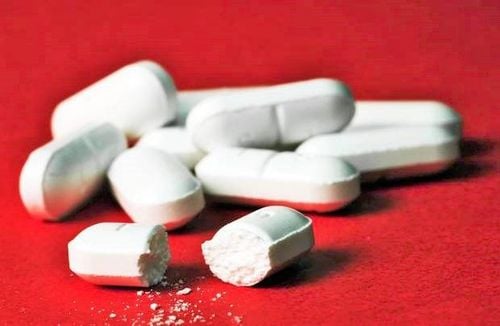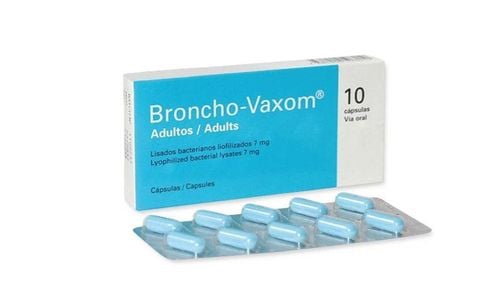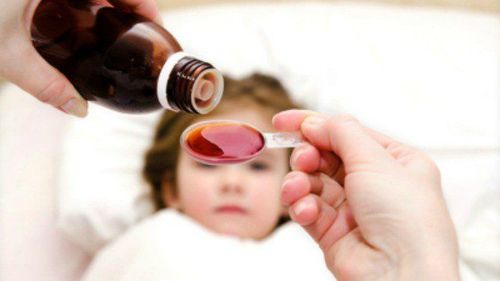This is an automatically translated article.
Dasagold cold and flu is an antipyretic, analgesic, used in the symptomatic treatment of flu cases or mild to moderate pain. Dasagold cold and flu is a prescription drug, so users need to know the use of the drug, consult a doctor to understand the dosage and note to use the drug effectively.1. What is Dasagold cold and flu medicine? Uses of Dasagold for colds and flu
Dasagold cold and flu medicine has the main ingredients:Paracetamol: 500 mg. Caffeine: 25 mg. Phenylephrine hydrochloride: 5mg. Excipients just enough for 1 tablet: Corn starch, PVP K30 (Polyvinylpyrrolidone), magnesium stearate, talc powder, DST (Sodium starch glycolate), PEG 6000, ponceau color. The active ingredient Paracetamol in Dasagold cold and flu medicine is a metabolite of Phenacetin, which has many other names such as Acetaminophen or N-acetyl-p-aminophenol. The main effect of Paracetamol is fever and pain relief similar to Aspirin if used in equal doses in mg. However, the anti-inflammatory effect of Paracetamol is quite weak compared to aspirin or other NSAIDs.
Paracetamol's analgesic mechanism is accomplished by inhibiting COX-2 activity in the CNS and decreasing the activity of the 5-hydroxytryptamine pathway, thereby reducing the transmission of sensory signals. pain perception. At the same time, Paracetamol dilates blood vessels and increases peripheral blood flow by acting on the hypothalamus, where the body's temperature regulation center is located, releasing heat and helping to reduce fever. As a result, Paracetamol does not affect body temperature in normal people and only lowers body temperature in people with fever.
Caffeine: As a derivative of xanthin, has the effect of stimulating the cerebral cortex, reducing the feeling of fatigue, drowsiness and increasing excitement, helping the senses to increase perception and work more efficiently. However, patients will fall into the neurosuppressive phase if caffeine is used for a long time.
Phenylephrine hydrochloride: has a direct effect on the α1-adrenergic receptors of the sympathetic nerve to constrict blood vessels, so it helps to reduce congestion in the nose and sinuses in cases of colds.
2. Indications and contraindications of the drug Dasagold cold and flu
Dasagold cold and flu medicine is indicated when it is necessary to treat symptoms of fever, pain relief, in cases of flu such as headache, nasal congestion, fever or external muscle aches.Dasagold cold and flu medicine should not be used in patients with the following conditions:
History of allergy to Paracetamol or any of its ingredients. Narrow angle glaucoma. Acute asthma. Prostate enlargement. Myocardial infarction, coronary artery disease. Cardiac arrhythmias in the form of tachycardia or extrasystoles. People with deficiency of the enzyme Glucose - 6 - Phosphate dehydrogenase. To ensure the safety of taking Dasagold cold and flu medicine, patients need to inform their doctor about their medical history or allergies so that the drug can be considered.
3. Dosage and how to use Dasagold cold and flu medicine
Dasagold cold and flu medicine is used orally. Patients should take Dasagold cold flu tablets whole with water, do not chew, break, crush because it can reduce the effectiveness of the drug. The drug can be taken at the same time or after a meal.Dosage:
Adults and children from 12 years of age and older: take 1 tablet/time, 2-3 times a day. Children under 12 years old: Dasagold cold and flu medicine is not recommended. The interval between 2 doses is at least 4-6 hours. The maximum dose is 4g / day and do not take Dasagold cold and flu medicine continuously for more than 7 days.
4. Side effects of the drug Dasagold cold and flu
When taking Dasagold, patients may experience some unwanted side effects such as:Paracetamol:
Common: Urticaria, skin rash, other allergic reactions, sometimes accompanied by fever or mucosal lesions . Uncommon: Nausea, vomiting, anemia, neutropenia, pancytopenia, nephrotoxicity with long-term and continuous use of the drug. Rare: Hypersensitivity reactions. Caffeine: Stimulates the digestive tract causing abdominal pain, diarrhea, ... or stimulates the central nervous system.
Phenylephrine hydrochloride :
Common: Restlessness, anxiety, insomnia, nervous excitability, fatigue, dizziness, chest pain, tremor, paresthesia of extremities. Hypertension, cold feeling, pale skin Uncommon: Pulmonary edema, arrhythmia, bradycardia, peripheral vasoconstriction, organ hypoperfusion, respiratory failure, euphoria Rare: Pathologies Cardiovascular diseases such as subpericardial hemorrhage, myocarditis. If the patient experiences the above symptoms while using Dasagold flu medicine, they should stop taking the medicine and go to the nearest medical facility for support.
5. Note when using Dasagold cold and flu medicine
Paracetamol is relatively non-toxic at therapeutic doses, there may be reactions such as pruritus, skin rash, urticaria. Other reactions such as anaphylaxis, angioedema, and laryngeal edema are rare. Caution should be exercised when administering the drug to anemic patients, because even though methemoglobin levels in the blood are already dangerously high, cyanosis may not be evident. When taking Dasagold cold and flu medicine for a long time, it can lead to a decrease in the total number of blood cells, white blood cells, and platelets in the blood. Patients should be warned about the risk of acute generalized exanthematous pustulosis syndrome, Steven-Johnson syndrome, toxic epidermal necrolysis or Lyell's syndrome. Dasagold should be used with caution in patients with impaired liver or kidney function. Do not drink alcohol while taking Dasagold cold and flu medicine because it will cause liver toxicity. Phenylephrine hydrochloride should be used with caution in the elderly, with cardiovascular disease such as heart block, bradycardia, arteriosclerosis or type 1 diabetes. Dasagold cold and flu medicine can be used for tasks that require concentration such as driving or operating machinery Pregnant and lactating women: Caffeine and Phenylephrine hydrochloride are likely to be excreted in breast milk, so do not use. Dasagold cold and flu drug in these subjects.6. Interaction of drugs Dasagold cold and flu
Dasagold cold and flu medicine may interact if used concurrently with the following drugs:For Paracetamol:
Phenothiazines: Potentially serious fever reduction if used with antipyretic therapy. Anticonvulsants such as Phenytoin, Barbiturates, Carbamazepine: Increases the hepatotoxicity of Paracetamol because the drugs are converted into substances that are toxic to the liver. Isoniazid: Increased risk of hepatotoxicity. Alcohol: increased risk of hepatotoxicity when used during treatment with Paracetamol. For Phenylephrine hydrochloride:
β-adrenergic blocker: Reduces the stimulant effect on the heart of Phenylephrine hydrochloride if used previously. Oxytocin: Increases blood pressure-raising effect. Phenothiazine: Reduces the blood pressure-raising effect of Phenylephrine hydrochloride. Digitalis: Increased myocardial sensitivity when used concomitantly with Phenylephrine hydrochloride. Bromocriptine: Causes vasoconstriction and hypertension. For caffeine: Decreased blood flow to the liver should prolong the half-life of the drug, thereby increasing the effect of drugs eliminated by the liver.
7. Overdose of Dasagold cold and flu medicine and treatment
Toxicity from overdose of drugs containing Paracetamol can occur from long-term administration, repeated large doses of Paracetamol or even a single dose. Hepatic necrosis is the most serious toxicity when taking drugs containing Paracetamol such as Dasagold for colds and flu. Overdose symptoms manifest with nausea, vomiting, abdominal pain immediately after 2-3 hours from the dose of toxic. Cyanosis on skin, mucous membranes, nails is a characteristic sign of methemoglobinemia in acute overdose of Paracetamol.Initial symptoms in the central nervous system are excitability, delirium. This is followed by neurological depression with manifestations of tachypnea, shallow breathing, tachycardia, hypotension, stupor, hypothermia, circulatory failure. In very large doses, Paracetamol will cause vasodilation, vasodilation and shock. A choking convulsion can lead to sudden death or a few days after being in a coma.
Signs of liver damage become obvious, blood aminotransferase increases, plasma bilirubin level increases, liver damage spreads after 2-4 days of toxic dose, leading to disorder of coagulation mechanism, eventually death from liver failure. Liver damage takes weeks to months to recover if the patient's case of liver necrosis is not fatal.
Phenylephrine hydrochloride overdose causes increased blood pressure, headache, palpitations, convulsions, cerebral hemorrhage, paresthesia.
Caffeine overdose causes convulsions
Treatment : Early diagnosis of a case of poisoning caused by an overdose of Dasagold cold and flu medicine is of the utmost importance, several tests can be used to help determine drug levels in the blood. However, treatment for poisoning should be carried out immediately while waiting for test results. Gastric lavage and active supportive treatment in all cases as soon as possible. The primary antidote with Paracetamol is N-acetylcysteine orally or intravenously immediately, preferably less than 10 hours after taking Paracetamol. If N-acetylcysteine is not available then Methionine can be used. Hypertension due to Phenylephrine hydrochloride overdose can be treated with α-adrenergic blocking agents such as Phentolamine 5-10mg intravenously and other supportive treatment.
Above is all information about Dasagold cold and flu medicine, it is necessary to consult a doctor and strictly follow the indications and doses to be effective and limit the risk of overdose or side effects of the drug. when using.
Please dial HOTLINE for more information or register for an appointment HERE. Download MyVinmec app to make appointments faster and to manage your bookings easily.













